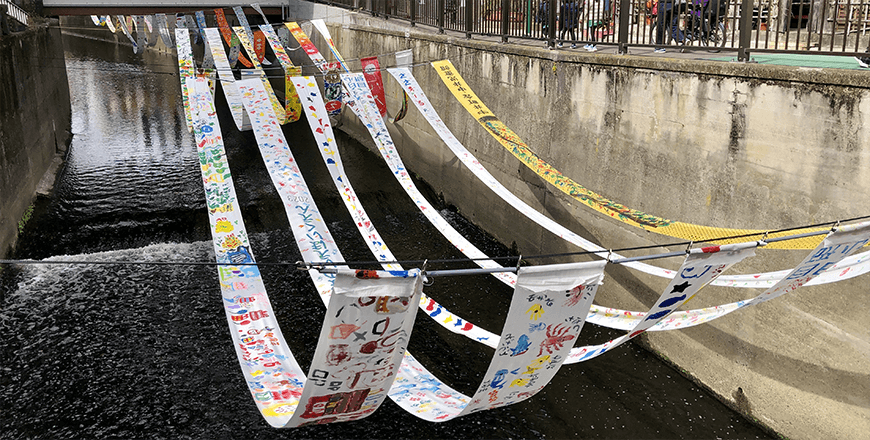
Located in a quiet corner of northwestern Shinjuku Ward, Nakai Station is not on most travelers’ itineraries when they arrive in Japan. But if you happen to be in the area in late February, you might be surprised to find colorful streamers of richly dyed and decorated silk hanging over the Myoshoji River as well as traditional noren curtains hanging over shopfronts. This is the Some no Komichi festival, a celebration of the area’s silk dyeing and kimono production heritage.
-
![Dozens of colorful bolts of silk hang over Tokyo’s Myoshoji River during the Some no Komichi dyeing festival.
Photo: Tim Hornyak]()
Dozens of colorful bolts of silk hang over Tokyo’s Myoshoji River during the Some no Komichi dyeing festival. Photo: Tim Hornyak
-
02
Some no Komichi
“Some no Komichi” can be translated as “dyed lanes.” This reflects the many narrow streets of the quarter as well as its role as a center for silk dyeing. The history of the industry can be traced back to the Edo period (1603–1867) when artisans gathered in Edo (the old name for Tokyo) after the city was established as an administrative center under the Tokugawa shogunate. Dyers were originally concentrated in the Kanda area to the east, and served large retailers in the Nihombashi district like Echigo-ya, founded in 1673 and the forerunner of today’s Mitsukoshi department store chain.
![The Some no Komichi dyeing festival takes place in late February around Nakai Station.
Photo: Tim Hornyak]()
The Some no Komichi dyeing festival takes place in late February around Nakai Station. Photo: Tim Hornyak
With the advent of industrialization, the river water became polluted, forcing artisans to move upriver. Since silk dyers require enormous amounts of water, the Nakai neighborhood was an ideal spot because it has both the Kanda River and the Myoshoji, one of its tributaries. From around the late 1920s through to the 1950s, the neighborhood had more than 400 dyeing factories, making it one of the principal centers for the industry in Japan along with Kyoto and Kanazawa.
As Japanese increasingly adopted Western-style clothing in the latter half of the 20th century, however, demand for kimono dropped off. There are fewer than 100 dyeing factories in the Nakai neighborhood today, according to the Shinjuku Textile Dyers Association. They employ traditional dyeing techniques such as Edo komon, a process involving hand-punching a stencil with small dots forming repeating patterns that are transferred onto white fabric with colored paste. At first glance, the patterns are almost invisible on the finished kimono. Another technique is Edo sarasa, a kind of paper-stencil dyeing that requires multiple stencils. -
03
Held annually in February
While the kimono industry is smaller today, the Some no Komichi event, held over three days in the last week of February, is a lively event that draws many kimono enthusiasts from Japan and abroad. Started in 2009 to increase awareness of the local dyeing industry, the festival has two main attractions: the River Gallery and the Street Gallery.
![Dozens of neighborhood shops and restaurants display beautiful traditional noren curtains during the festival.
Photo: Tim Hornyak]()
Dozens of neighborhood shops and restaurants display beautiful traditional noren curtains during the festival. Photo: Tim Hornyak
The River Gallery refers to the 50 to 60 silk bolts called tanmono fluttering over the Myoshoji, between Sakae-bashi and Taisho-bashi bridges, along both sides of the Yamate-dori overpass. Measuring 12 to 13 meters long and 36 to 40 centimeters wide, tanmono are the building blocks of kimono. They are hung over the waters to commemorate the traditional method of washing freshly dyed bolts of fabric in the river, a practice called mizumoto that continued until the 1960s; artisans would also dry the fabrics on tower-like racks by the river. The bolts include discarded fabrics from master dyers and fabrics that have been dyed by local schools and organizations.
-
04
Street Gallery
The Street Gallery, meanwhile, features dozens of traditional noren curtains outside local shops. While noren can be found hanging at many traditional shops, restaurants and bathhouses all over Japan—indicating that the shops are currently open—the curtains in the Street Gallery are the work of masters as well as local university students. Each has its own beautiful design and dyeing techniques.
![The Nakai district has shops selling second-hand kimono, kimono accessories, noren and other traditional handicrafts.
Photo: Tim Hornyak]()
The Nakai district has shops selling second-hand kimono, kimono accessories, noren and other traditional handicrafts. Photo: Tim Hornyak
Apart from the tanmono and noren, the neighborhood is full of shops selling second-hand kimono, kimono accessories and other traditional handicrafts, as well as dyeing factories and workshops open to the public such as Some no Sato Ochiai. It’s also home to the Hayashi Fumiko Memorial Hall, a traditional house of exquisite craftsmanship built in 1941 that today commemorates the author Fumiko Hayashi (1903–1951), best known for Diary of a Vagabond and Floating Clouds.
Access: Nakai Station is a stop on both the Odeo Subway Line and Seibu Shinjuku Line, in Tokyo










